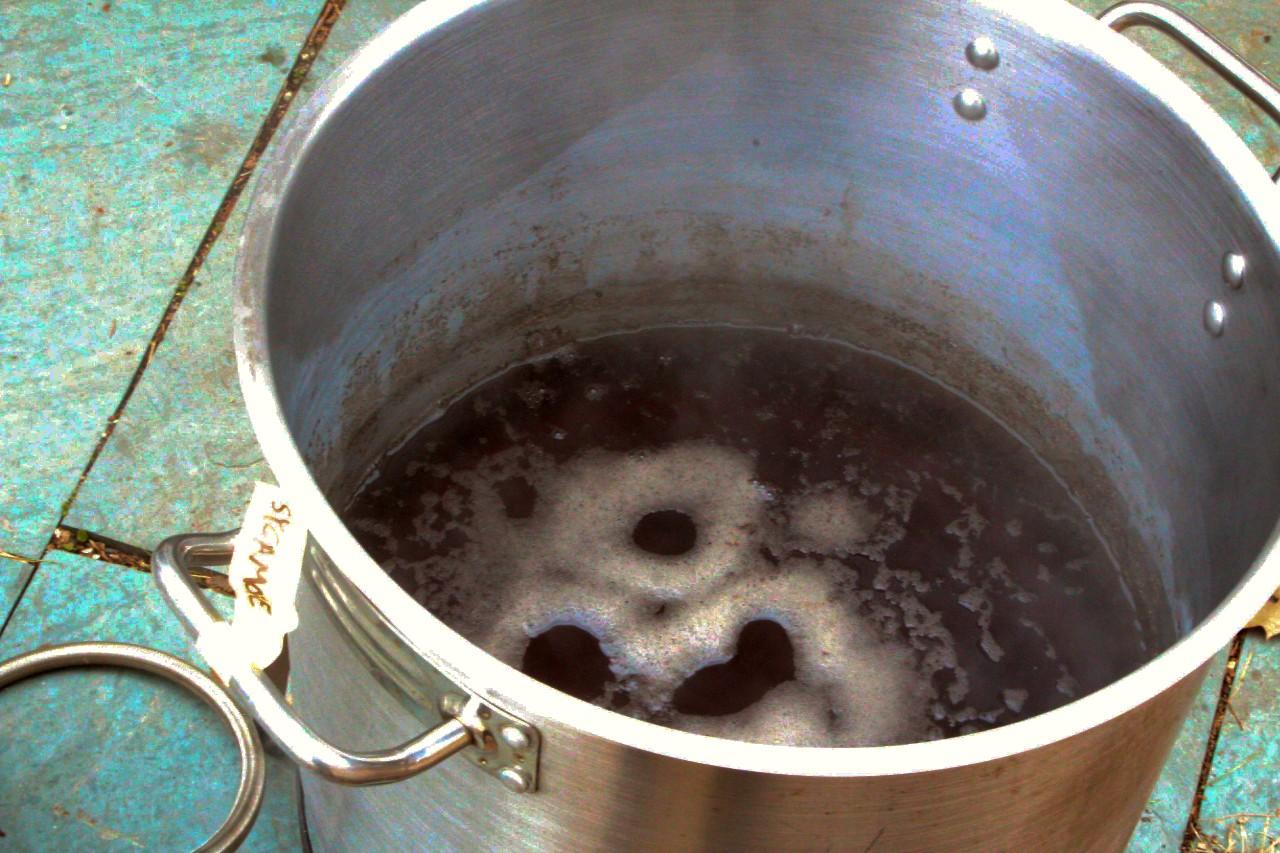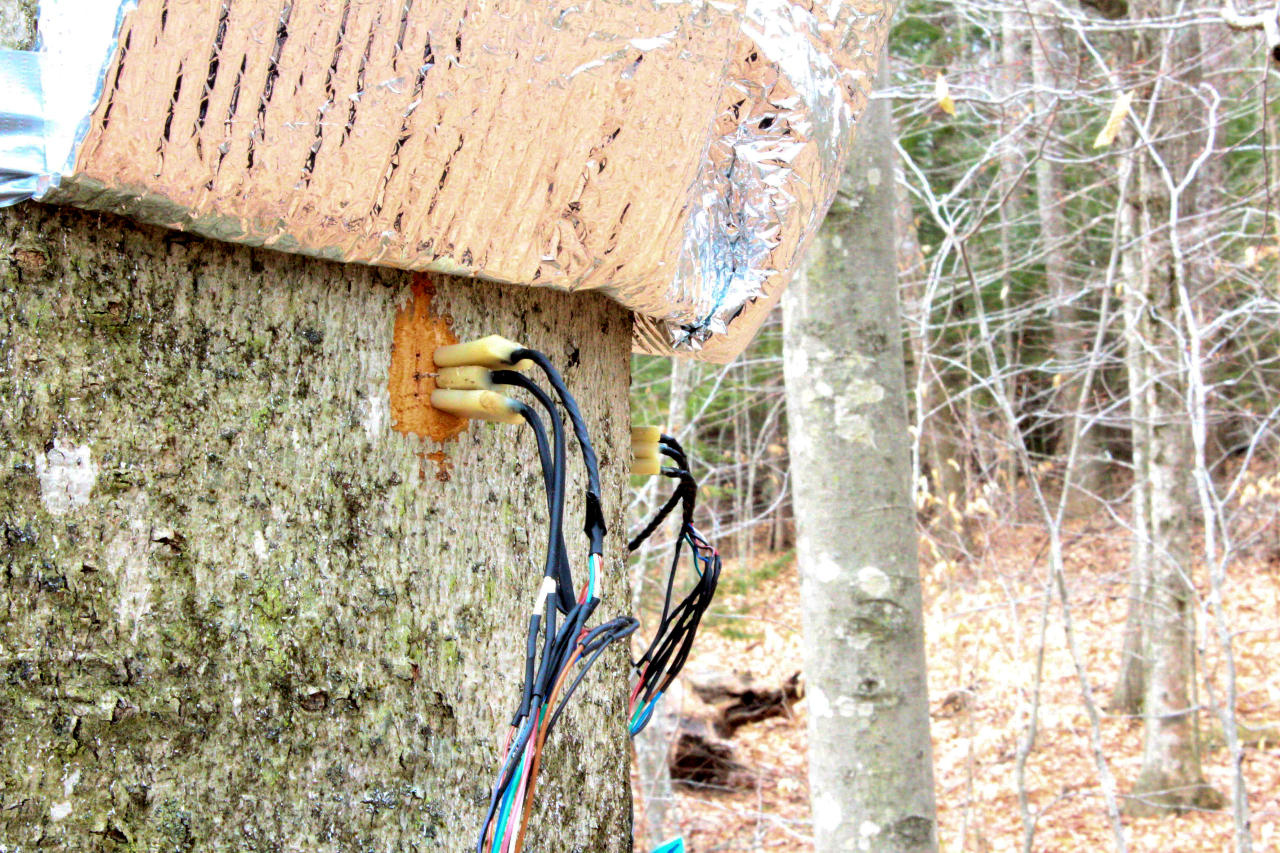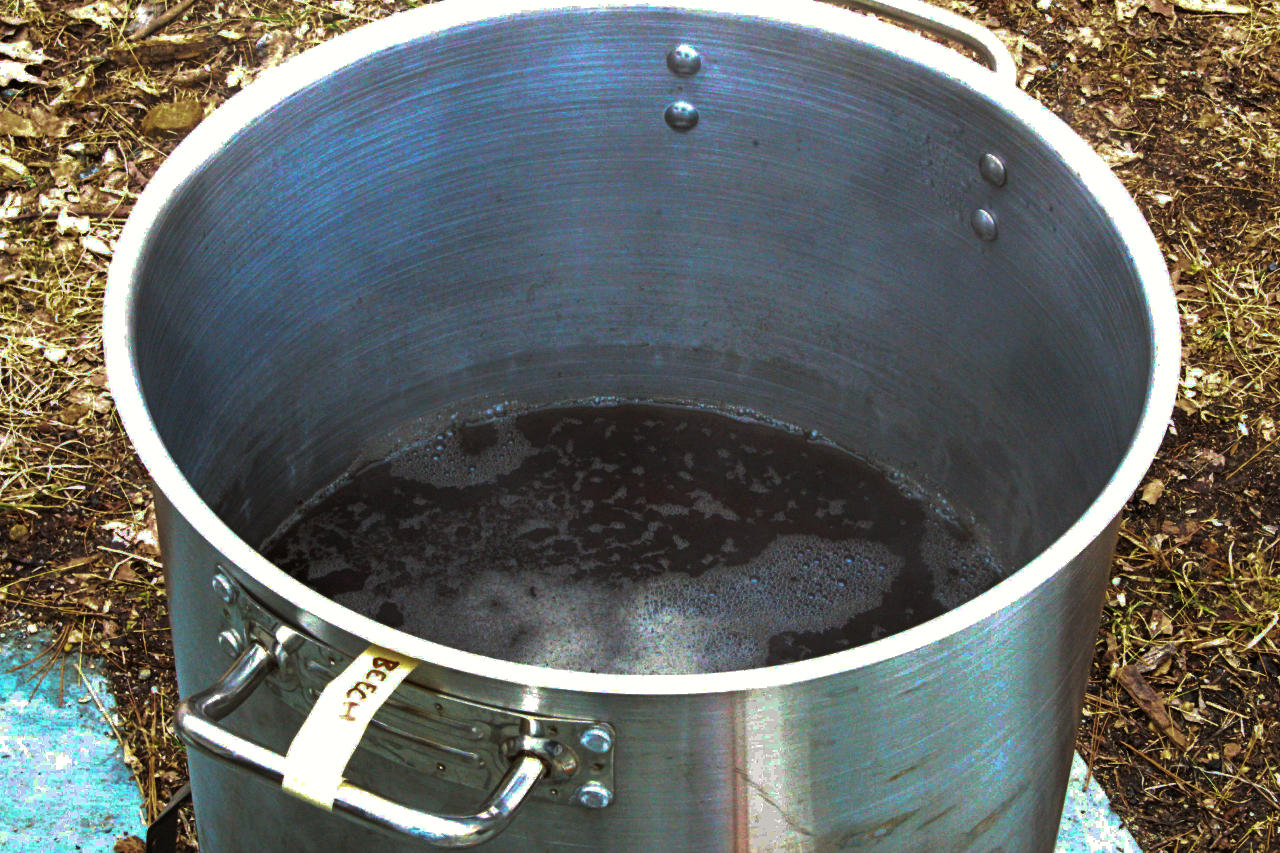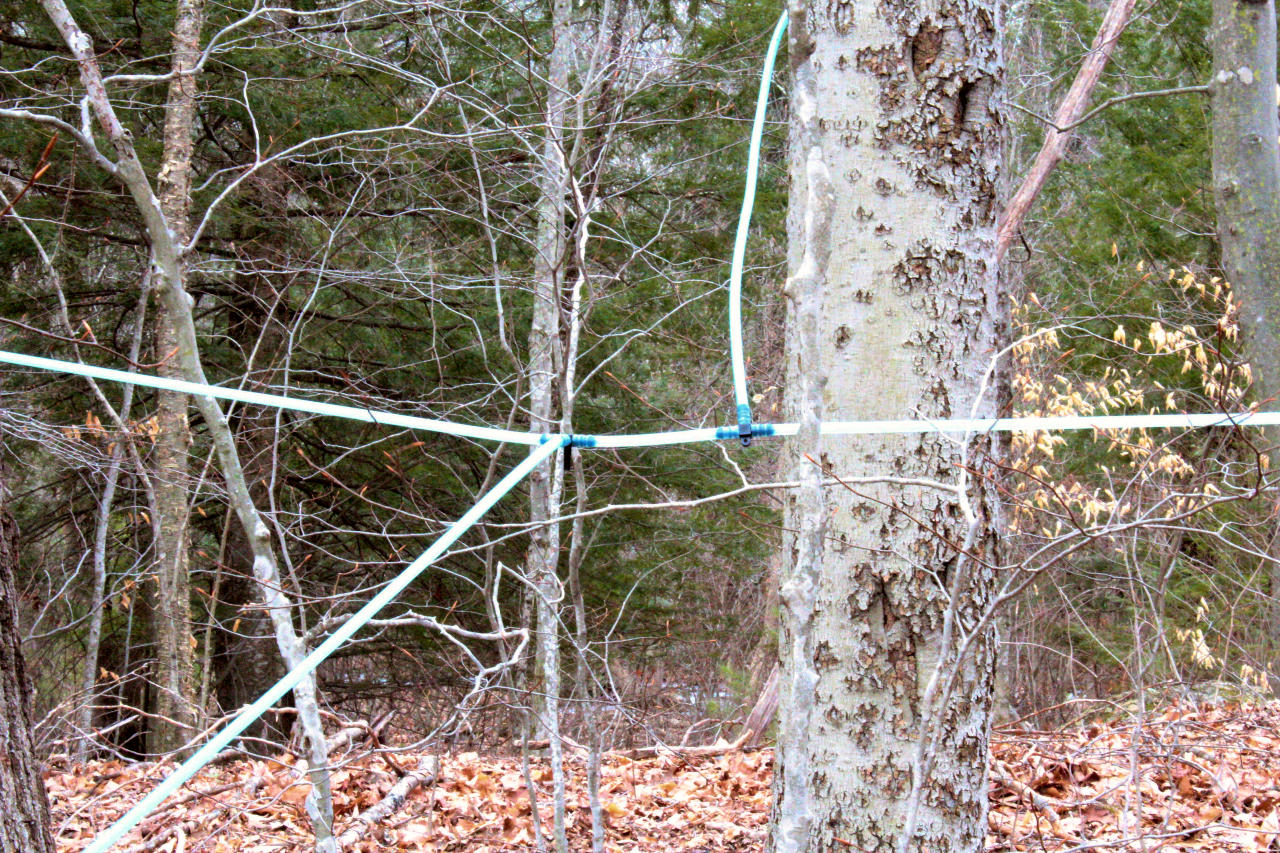Making Syrup From More Than Maple Trees
7:15 minutes

 This segment is part of The State of Science, a series featuring science stories from public radio stations across the United States. This story was reported by Annie Ropeik on NHPR.
This segment is part of The State of Science, a series featuring science stories from public radio stations across the United States. This story was reported by Annie Ropeik on NHPR.
Researchers at the University of New Hampshire are studying new ways to make syrup out of the northern forest—not from maple trees, but from beeches, birches, sycamores and more. They want to create new markets for an industry that, right now, depends on just one kind of tree—making it vulnerable to disease and climate change.
At the tail end of maple sugaring season, other kinds of sap were still flowing freely in the woods of Lee. UNH researcher David Moore had sensors plugged into a stand of beech trees to measure that sap and the conditions helping produce it.

“You can see I have three trees with sensors here that are all tied back to one data logger,” Moore said, pointing to the tubes and wires running from the beech trunks. Nearby, a bucket collected the resulting sap, while other equipment gathered weather data.
Researchers say monocultures, like the all-maple syrup industry, are more at risk from climate change, pests and other unpredictable threats.
So Moore sees untapped potential in other common species, like the American beech. It’s found throughout New Hampshire’s forests, farms and sugar bushes—almost like a tree weed.
“If you can think of some economical use—if you can make syrup from them, that would be a nice way to actually generate a little profit from them,” Moore said.
Moore did that successfully for six years with his business, the Crooked Chimney, which sold syrups like birch and beech at farmers markets and to restaurants. It took a while for him fine-tune the process – these species don’t like all the same temperatures and equipment as maples.
“The first year or two were a real learning curve for me,” Moore said. “But once I figured it out, I started tapping a lot more trees and selling syrup, and it turned out to be pretty good tasting syrup.”
In the driveway of his house in Lee, he was steaming off some beech and sycamore syrup in big metal pots—the way maple syrup is boiled in a sugar shack. Part of Moore’s study at UNH aims to find the best processing techniques for these more finicky, less tested saps.
For a taste test, he produced two tiny glass bottles—one of birch syrup he made a few years ago, and one of beech syrup from New York-based New Leaf, run by Moore’s friend Mike Farrell.

“Let’s start with the beech,” Moore said, pouring a caramel-colored spoonful. “I’m always interested to see what people think of it.”
The beech syrup had a mild, sweet flavor—almost indistinguishable, at least to this reporter, from maple syrup.
The next spoonful, of Moore’s own New Hampshire birch syrup, was very different: dark and thick like molasses, with a tangy, savory flavor.
“I like to use it on meat—salmon and red meat,” Moore said. “You can mix it with balsamic vinegar and olive oil and make a nice salad dressing. Actually, my favorite use is probably ice cream.”
This kind of syrup is usually sold in little bottles, at higher prices. But buyers see the value.
Evan Mallett is the chef-owner at Black Trumpet Bistro in Portsmouth. He likes tree syrup as a sweetener because it’s less processed, more local and sustainable than cane sugar. He’s used birch syrup in cocktails, in braises for venison and wild boar, and once, drizzled on an ostrich loin.
“Definitely, people respond by saying, ‘Oh, that’s cool, I had no idea that you could harvest the sap of these other trees as well,’” Mallett said. “So it opens up that conversation, which can be a conservation conversation, an ecology conversation.”
Mallett says using unexpected local ingredients like this helps connect people in a “magical” way to nature, their food system, and a very old and widespread tradition.
He mentions sorghum and watermelon syrups in the south, and boiled cider in the Adirondacks. Indigenous people and European colonizers traded techniques for getting sugar from trees. In Alaska and parts of Canada, where fewer maples grow, birch syrup is already well established.

“It’s kind of remarkable that our sugar maple syrup industry has been so productive and sustainable overall, for such a long period of time, considering that it’s essentially relied on just the one single species,” said UNH forestry professor Heidi Asbjornsen, who oversees David Moore’s research.
She said supporting more diversity in syrups isn’t just interesting, it’s critical to the health of the changing forest. It’s clear, she said, that spring is getting less predictable, which affects sap flow.
“We’re going to see more variable years in terms of good versus bad sugaring seasons and sap yields,” Asbjornsen said.
Heat waves, droughts, ice storms—they could all affect maple trees. Vermont’s syrup association had a short season with low sugar content this year, amid warm, dry conditions.
On the other hand, freeze-thaw cycles are a big part of what drives sap flow. Those are also on the rise, which could be good for sugaring.
New York-based syrup-maker Mike Farrell—producer of the beech syrup we tasted earlier—has a different fear: a specialized pest or disease, like emerald ash borer or chestnut blight.
“It’s not the climate change becoming hotter and drier that’s going to do it,” Farrell said. “It’s if something like Asian longhorn beetle got out and wiped out all the maples—that would be devastating.”
Researchers are trying to convince farmers that the more diverse their forests and products are, the more resilient they’ll be. And they hope consumers will start to like the new flavors of these syrups, too.
Annie Ropeik is an environmental reporter for New Hampshire Public Radio in Concord, New Hampshire.
JOHN DANKOSKY: We’re moving now to the other side of the country, to New Hampshire, where researchers, hobbyists, and chefs are experimenting with something new for your breakfast table. Instead of reaching for some maple syrup for your pancakes, how about some birch syrup? Some beech syrup? How about sycamore? This is all in an effort to be more sustainable, to stop relying on just one type of tree for all of our syrupy needs.
Joining me today is my guest Annie Ropeik. She reports on the climate, energy, and environment for New Hampshire Public Radio. Annie, welcome back to the show. Thanks so much for joining us.
ANNIE ROPEIK: Hi John. Thanks for having me.
JOHN DANKOSKY: So in your state, I know that maple syrup’s a very big deal. So why are people looking into all these alternatives?
ANNIE ROPEIK: Well, they want to be clear, they are not looking to abandon maple trees. But they’re looking to branch out. I mean– and the puns abound in this story, so you know, forgive me in advance. They are looking to start using new kinds of trees to mix in with their maple rotation to kind of reduce some stress on the maple trees, give them some options if the worst were to happen to their maple trees, and maybe create some new sort of niche markets in the syrup world to sell some new and interesting flavors to customers, hopefully.
JOHN DANKOSKY: I know that there are a lot of types of trees that are really in trouble in the Northeast. Does this mean that maple trees and maple syrup might be in trouble?
ANNIE ROPEIK: So not necessarily. And it depends on who you ask. There’s a lot of unanswered questions about how climate change will affect maple trees. For example, researchers are only just starting to look at the effects of drought on trees in the Northeast. There’s not a ton of research about drought up here. There’s not even a great understanding of exactly how climate change might increase drought here.
But we know that it will bring more volatility, so more spikes in temperature, more, you know, unseasonable warmth or late season cold snaps, big storms, that kind of thing. And in one way, this could be actually good for maple trees and all kinds of syrup, because they rely on freeze-thaw cycles to run their sap. So more of those sort of winter whiplash temperatures, as we call them, could increase sap yields. But on the other hand, any kind of stress to a tree is going to make it produce less of everything that it’s supposed to produce. And so for example, in Vermont this past season, they saw a low sugar content and kind of a short season because things were so warm.
And then there are just concerns about pests. We haven’t seen a disaster in the maple world for something like an emerald ash borer or chestnut blight that could wipe out all of the maple trees, but if that were to happen, some sort of invasive pest that would target maples, that would be disastrous. And so part of this study and this sort of new endeavor in the syrup world is to just make some failsafes if any of that were to come to pass.
JOHN DANKOSKY: I’m John Dankosky, and this is Science Friday from WNYC Studios. And we’re talking about alternative maple syrups with NHPR reporter Annie Ropeik. I want to play a clip from your story, Annie, from Heidi Asbjornsen. She’s a forestry professor at the University of New Hampshire.
HEIDI ASBJORNSEN: It’s kind of remarkable that our sugar maple syrup industry has been so sustainable overall considering that it’s essentially relied on just this one single species.
JOHN DANKOSKY: Annie, it is kind of remarkable that the maple tree has been used in this way, basically by itself, for such a long time.
ANNIE ROPEIK: Yeah, it’s a monoculture, you know, and monocultures are at risk for disruption, like all of the issues that we just talked about. I used to report in the Midwest, in Indiana, on things like corn and soybeans, which are famous monocultures. And they have all kinds of ecological ramifications, things you need to do with crop rotations and things like that to kind of account for the fact that you’re just growing one single species over huge areas, which is not how nature usually likes to operate.
So you know, maple syrup is a little different. These are still natural forests, but they’re managed to encourage maple production. That would be what we would call the sugarbush, so a plot of forest that’s been maybe culled a little bit to have mostly maples and not so much of everything else. And you know, that just makes it more at risk of one big maple-centric disruption. And so some of the trees that they’re looking at trying to get some of these niche syrups from are the kind that really like to grow in a sugarbush and are typically ignored or cut back. And researchers are interested in seeing whether that might want to change.
JOHN DANKOSKY: All right, well, this is the important question, Annie– none of this actually works if the stuff doesn’t taste good. So what do some of these alternative syrups taste like?
ANNIE ROPEIK: That’s a great question, because I know that is the question on everyone’s minds. So some of them taste a lot like maples, like frankly pretty indistinguishable from maples. Beech syrup, for example, tastes a lot like maple syrup. It’s a little milder. It can be sort of lighter in color. But frankly, if you hadn’t told me when I tasted it that it wasn’t maple syrup, I wouldn’t have known the difference.
Birch syrup, on the other hand, which listeners in places like Alaska or out West might be familiar with already– it’s a little more common there because they don’t have as many maple trees– birch syrup is a lot different. It almost was like molasses, or kind of a balsamic-y, like, savory flavor. I thought it seemed like it would be better for cooking, and that was what the researcher I was talking to said he likes to do with it. He uses it in marinades on meat and fish. He puts it in salad dressing. He also said he likes to put it on his ice cream.
JOHN DANKOSKY: These are all good options. I kind of want to try some of these. So how does the actual sugaring process work for these syrups? Is this basically the same as making maple syrup?
ANNIE ROPEIK: It’s close, but just different enough to be really tricky. And that’s what the study at the University of New Hampshire that I reported on is looking at. They want to know sort of what are the little tricks that are a little bit different from maple that will make people most successful when they try these other kinds of syrup.
So some of these, for example, they don’t like a metal bucket. They will pick up the flavor of metal. And so you’re supposed to use plastic. Or they burn more easily than maple syrup, so they scorch at lower temperatures that would be friendly to maple.
And the researchers I’ve been talking to say, if people are just trying this kind of as hobbyists or as a maple producer just seeing what they can do with these extra trees, they might not think it works. They might think that these trees don’t work for sugaring, which is not the case. You just have to kind of fine-tune the process and know how to do it a little bit differently from maple syrup– the different processes, temperatures, times that will make them successful– which is what the UNH study is trying to do, is kind of get some best practices together to help more people get into this.
JOHN DANKOSKY: Do you think it’s realistic that we could see any of these syrups on the market, like available for us at a breakfast table anytime soon?
ANNIE ROPEIK: So they are on the market already in really small sort of novelty quantities. And the folks I’ve been talking to say that’s probably how it’s going to stay. It’s a little more expensive to do these, just because they do require some different equipment sometimes. And it is completely in addition to any maple sugaring you’re already doing. But you could see it maybe more readily available at your farmer’s market, or in fancy restaurants and that kind of thing locally.
JOHN DANKOSKY: Annie Ropeik reports on the climate, energy, environment, and sometimes pancakes for New Hampshire Public Radio’s By Degrees project. Annie, thanks so much for joining me. I appreciate it.
ANNIE ROPEIK: Thank you, John.
Copyright © 2021 Science Friday Initiative. All rights reserved. Science Friday transcripts are produced on a tight deadline by 3Play Media. Fidelity to the original aired/published audio or video file might vary, and text might be updated or amended in the future. For the authoritative record of Science Friday’s programming, please visit the original aired/published recording. For terms of use and more information, visit our policies pages at http://www.sciencefriday.com/about/policies/
Kathleen Davis is a producer and fill-in host at Science Friday, which means she spends her weeks researching, writing, editing, and sometimes talking into a microphone. She’s always eager to talk about freshwater lakes and Coney Island diners.
John Dankosky works with the radio team to create our weekly show, and is helping to build our State of Science Reporting Network. He’s also been a long-time guest host on Science Friday. He and his wife have three cats, thousands of bees, and a yoga studio in the sleepy Northwest hills of Connecticut.